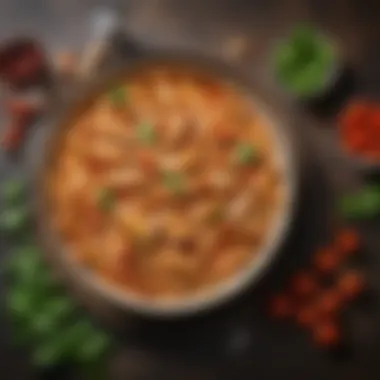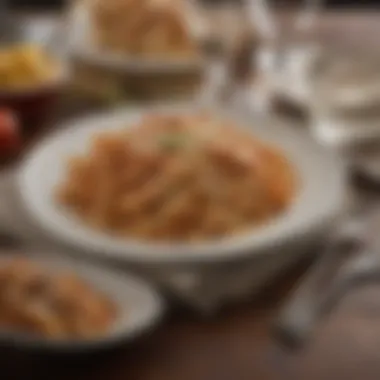Delicious Chicken Penne Pasta Recipes with Tomato Sauce


Recipe Overview
Dish Name: Savory Chicken Penne with Tomato Sauce
- Portions: 4 servings
- Time Required: 30 minutes (Prep: 10 minutes, Cook: 20 minutes)
- Difficulty Level: Easy
- Main Ingredients:
- Chicken breast
- Penne pasta
- Fresh tomato sauce
- Garlic
- Olive oil
- Basil
This recipe for Savory Chicken Penne with Tomato Sauce is designed to merge ease and flavor for those with busy schedules. The simplicity of the ingredients paired with the quick preparation and cooking time makes it ideal for weeknight dinners. The dish not only satisfies hunger but is also appealing in flavors and appearances.
Step-by-Step Instructions
Ingredient Preparation
- Chicken Breast: Dice the chicken breast into bite-sized pieces.
- Garlic: Mince two to three cloves of garlic.
- Tomato Sauce: Use 2 cups of fresh tomato sauce. If unavailable, canned tomato sauce works too.
- Basil: Chopped fresh basil adds aroma and flavor.
Cooking the Dish
- Boil Penne Pasta: Start by boiling water in a large pot. Add salt and then 3 cups of penne pasta. Cook according to package directions, usually 10 to 12 minutes until al dente. Drain and set aside.
- Cook Chicken: In a large skillet, heat 2 tablespoons of olive oil over medium heat. Add diced chicken and cook for about 6 to 8 minutes until golden brown.
- Add Garlic: Stir in the minced garlic for about 30 seconds. Avoid burning it.
- Incorporate Tomato Sauce: Pour in the tomato sauce and let it simmer for 5 minutes.
- Mix with Pasta: Combine cooked penne with the sauce and chicken. Stir until well coated.
- Garnish: Finally, sprinkle fresh basil on top before serving.
Time-saving Strategies
- Use pre-diced chicken for quicker preparation.
- Consider frozen garlic cubes if you do not have fresh garlic.
- Cook pasta in advance and refrigerate it for future meals.
Nutritional Information
- Calories per Portion: Approximately 450 calories
- Protein: 30g
- Fat: 12g
- Carbohydrates: 56g
This dish offers not only delicious taste but also a good balance of nutrients, primarily from protein-rich chicken, giving it a healthy profile.
Quick Cooking Tips
- Kitchen Gadgets: A slow cooker can help cook chicken tenderly.
- Multitasking: While the pasta boils, prepare the sauce to save time.
- Alternatives: Try zucchini noodles for a lighter meal or whole grain penne for added fiber.
Related Recipes & Variations
- Grilled Chicken with Tomato Basil Sauce
- Spicy Chicken Penne in Arrabbiata Sauce
- Vegetarian Penne Pasta with Tomato and Spinach
Feel free to share your adaptations and creative variations of this chicken penne pasta with tomato sauce.
Preamble to Chicken Penne Pasta
Chicken penne pasta represents a harmonious blend of flavors and textures. This dish is much more than just a quick meal; it serves as a canvas for culinary creativity. The various elements, such as the type of pasta, the chicken, and the chosen sauce, contribute significantly to the overall experience. Understanding these components is essential for anyone who wishes to prepare a dish that is both satisfying and delicious.
Understanding Penne Pasta
Penne pasta, characterized by its distinct tube shape and diagonal cuts at the ends, is well-suited for holding sauces. This type of pasta can capture ingredients and flavors, ensuring that each bite delivers a balanced taste. The ridged surface of penne also enhances its ability to cling to sauces, making it a popular choice in many recipes. Choosing the right kind of penne can elevate a dish; options range from whole wheat to gluten-free varieties. This adaptability is essential for catering to different dietary needs and preferences. Understanding how penne interacts with sauces can also influence preparation techniques, an aspect that is beneficial for achieving the desired texture and flavor.
The Role of Chicken in Pasta Dishes
Chicken adds protein, texture, and depth to pasta dishes. Its mild flavor allows it to absorb the seasonings and sauces used in cooking, making it an excellent companion for penne pasta. Various cuts of chicken, such as breasts or thighs, can be used, each providing a unique taste and texture. The method of cooking chicken, whether grilled, sautéed, or baked, also affects the overall outcome of the dish. Proper seasoning and marinating techniques can amplify the flavor profile of the chicken, resulting in a more enjoyable meal. This versatility makes chicken a staple in pasta cuisine, highly regarded among both home cooks and culinary professionals.
The Importance of Tomato Sauce


Tomato sauce serves as the heart of many pasta dishes, including chicken penne. It can transform a simple dish into something remarkable with its rich, tangy flavor. There are various types of tomato sauce, from marinara to arrabbiata, each offering a distinct taste experience. The acidity of the tomatoes balances well with the richness of the chicken and the starchiness of the pasta. Additionally, one can customize tomato sauce with herbs, spices, and additional ingredients like vegetables or cheese to create unique flavor combinations. This flexibility allows cooks to express their creativity while catering to differing palates.
Understanding the foundational elements of chicken penne pasta is crucial for any culinary enthusiast. Proper ingredient selection and cooking techniques can result in a satisfying and flavorful meal, suited to various occasions.
Key Ingredients for Chicken Penne Pasta
The success of any chicken penne pasta dish lies in the selection of high-quality ingredients. Each component plays a crucial role in developing flavor, texture, and nutritional value. This section will explore essential ingredients to ensure a satisfying culinary experience.
Choosing the Right Chicken
Selecting the correct chicken is fundamental for a delicious penne pasta. Freshness is key. Ideally, you should consider using organic or free-range chicken. Such options tend to have richer flavor and better texture compared to conventional products. This is due to their diet and living conditions, which enhance overall taste.
When choosing chicken, pay attention to its cut. Breast meat is popular for its leanness and versatility. However, thighs may provide more flavor and moisture, making them a good choice for richer dishes. It's important to consider cooking methods too. Grilling or sautéing can add distinct flavors that enhance the pasta dish. Also, remember to trim any excess fat to maintain a balanced flavor profile.
Selecting Quality Penne Pasta
Penne pasta is the shape of choice here, and understanding quality is essential. When selecting pasta, look for options made from 100% durum wheat semolina. This type of wheat has a higher protein content, which offers better cooking performance and texture. Avoid generic brands that may compromise on ingredient quality.
It's also worth noting the importance of thickness and ribbed surface. A thicker penne retains sauces better, while a ribbed surface allows for more adherence of tomato sauce. Choosing a good brand might make all the difference. Look for trusted names like Barilla or De Cecco, which have a reputation for quality.
Types of Tomato Sauce
Tomato sauce is a key element that ties the dish together. The type of tomato sauce you choose can significantly influence flavor. Options vary from marinara to arrabbiata, each offering unique characteristics.
Marinara sauce typically features simple ingredients, focusing on tomatoes, garlic, and herbs like basil. It provides a classic touch to many pasta dishes. Alternatively, arrabbiata has a spicy kick, ideal for those who enjoy heat.
You might also consider using San Marzano tomatoes for a more authentic flavor. Their natural sweetness and low acidity create a well-rounded sauce. Lastly, pre-made sauces can save time but do check for high-quality brands with minimal preservatives and natural ingredients.
Fresh ingredients can greatly elevate your pasta dishes, making each meal an experience worth savoring.
Basic Chicken Penne Pasta Recipe
The section on the Basic Chicken Penne Pasta Recipe serves as the core of this article, outlining a foundational dish that combines accessible ingredients and straightforward methods. Understanding how to create a basic version offers many benefits. Firstly, it lays the groundwork for more complex variations. Secondly, it accommodates different tastes and dietary needs, making it versatile. Thirdly, mastering this simple recipe enhances confidence in the kitchen, serving as a launching pad for culinary exploration.
Preparation Steps
Preparation is a crucial element in cooking any dish, and chicken penne pasta is no exception. To begin with, organize all ingredients. This includes chicken breasts, penne pasta, tomato sauce, garlic, onion, olive oil, and your choice of herbs. Having everything ready saves time during the cooking process.
Here are the steps to prepare your ingredients:
- Chicken: Trim the chicken breasts if needed. Cut them into bite-sized pieces. This encourages quicker and more even cooking.
- Pasta: Measure the penne according to the servings desired. It is common to use approximately two ounces of dried penne per person.
- Vegetables: Chop onion and garlic finely. These will add flavor and aroma to the dish.
After completing the preparations, place the ingredients within easy reach. Ensuring everything is organized aids in maintaining a smooth workflow during cooking.
Cooking Method
The cooking method for chicken penne pasta requires attentiveness to ensure the best results. Begin by cooking the penne in a pot of salted boiling water. The pasta requires about 10-12 minutes until al dente, where it remains firm to the bite. Remember to stir occasionally to prevent sticking.
While the pasta cooks, heat a pan over medium heat and add olive oil. Once the oil is warm, add garlic and onion. Sauté until they become translucent, which usually takes around three to five minutes. Next, add the prepared chicken pieces to the pan. Cook for approximately 6-8 minutes, turning often until the chicken is fully cooked and no longer pink inside.
Once chicken is ready, pour the tomato sauce into the pan. Allow it to simmer for about 5 minutes, which helps meld the flavors. Finally, combine the cooked penne with the chicken and sauce. Stir to evenly coat the pasta.
At this point, the dish is essentially complete. You can serve it immediately as is, or enhancements like grated cheese or fresh basil can be added for extra flavor.


This straightforward cooking method ensures quick preparation, making it practical for busy evenings.
Variations of Chicken Penne Pasta
Exploring different variations of chicken penne pasta is significant for both home cooks and culinary enthusiasts. Variations can cater to diverse tastes and dietary needs, ensuring that everyone can find a version of this dish that they enjoy. Each variation not only adds new flavors but also opens up different approaches to preparation and cooking.
By adapting the basic chicken penne pasta recipe, cooks can experiment with ingredients to create a meal that suits their cravings or available resources. This flexibility is essential for maintaining excitement in meal planning. In this section, we will look at three specific variations: the creamy tomato sauce variation, spicy chicken penne pasta, and vegetarian adaptations.
These adaptations are not merely alternatives but enriching additions to the culinary palette that underline the versatility of chicken penne pasta. Let's explore each of these variations in detail.
Creamy Tomato Sauce Variation
The creamy tomato sauce variation brings a rich and luscious texture to the classic dish. This variation uses a base of tomato sauce mixed with heavy cream or a vegan alternative like coconut cream. The result is a velvety sauce that coats the penne pasta beautifully and elevates the overall dining experience.
To make this variation, start by preparing a traditional tomato sauce. Once the sauce simmers, introduce the cream and allow it to mix thoroughly. It is essential to stir continuously to prevent the cream from curdling. This version can be enhanced with herbs such as basil or oregano, infusing it with aromatic qualities. For additional depth, consider adding sautéed onions and garlic to the sauce prior to integrating the cream. This variation offers a comforting option, especially on cooler days.
Spicy Chicken Penne Pasta
For those who appreciate a kick in their meals, the spicy chicken penne pasta variation is an excellent choice. This dish incorporates chili flakes, diced jalapeños, or even a spicy sausage to intensify the flavor profile.
Start by marinating the chicken pieces in a blend of spices that includes cayenne pepper or paprika before cooking. As you sauté the chicken, add garlic and onion to enhance its flavor. Once cooked, toss the chicken with your spicy tomato sauce, giving it time to absorb the heat and blend flavors. The blend of spice not only increases the dish's appeal but also creates a memorable meal experience that excites the palate. This variation can be easily adjusted according to the preferred level of heat.
Vegetarian Adaptations
Vegetarian adaptations of chicken penne pasta focus on substituting chicken with ingredients that offer similar texture and flavor. Options include mushrooms, tofu, or even hearty vegetables like zucchini and bell peppers. This approach provides a nutritious and satisfying meal without meat.
For the sauce, maintain the original tomato base but consider adding nutritional yeast for a cheese-like flavor or cream for richness. The key is to think creatively about the substitutions while ensuring that the dish remains well-seasoned and balanced. An emphasis on fresh herbs and spices can further enhance the taste profile.
Incorporating variations into chicken penne pasta allows individuals to personalize their dining experience. Whether seeking comfort food, a spicy meal, or vegetarian options, these variations enhance the dish’s versatility and have the potential to make any meal memorable.
Nutritional Considerations
Nutritional considerations are a key aspect of Chicken Penne Pasta recipes, especially when pasta and sauce can often be perceived as indulgent. It is essential to explore how the right ingredients not only enhance flavor but also contribute to overall health. Each component of this dish plays a role in delivering important nutrients, helping to create a balanced meal. Understanding these factors can guide individuals toward healthier choices without sacrificing taste or enjoyment.
Caloric Content
Caloric content is an important aspect to consider when preparing Chicken Penne Pasta. A typical serving may contain around 400 to 600 calories, depending on the ingredients used. The chicken contributes protein but also calories. Similarly, penne pasta can add significant calories, especially if consumed in large portions. For those mindful of their caloric intake, consider moderating the amount of pasta. You might also explore whole wheat options, which offer more fiber and a lower caloric count per serving. Adjusting these elements can accommodate various dietary needs while keeping the dish satisfying.
Protein Sources
Protein is vital for muscle health and overall bodily functions. Chicken is an excellent protein source, providing approximately 25 grams per 3-ounce serving. Options like grilled or roasted chicken can provide leaner protein, whereas fried chicken is higher in fat and calories. In addition, you can enhance the protein content by adding ingredients like beans or chickpeas. This can also cater to vegetarians looking to enjoy Chicken Penne Pasta adapted without chicken. The protein sources you select can significantly affect the nutrition profile of the dish.
Balanced Meal Composition
A balanced meal composition is crucial for health. Chicken Penne Pasta can achieve this by combining proteins, carbohydrates, and fats. To enhance balance, the inclusion of vegetables is beneficial. For example, bell peppers, spinach, or broccoli can add vitamins and minerals, contributing to the overall nutritional value. Ensuring a good ratio where protein, carbohydrates, and fiber coexist is important. This not only promotes better digestion but also sustains energy levels throughout the day.
"By focusing on balance and the quality of ingredients, you can enjoy Chicken Penne Pasta while supporting your nutritional needs."
Cooking Tips and Tricks
Cooking chicken penne pasta with tomato sauce can be simple, yet it is an art that benefits from a few insightful tips and tricks. Understanding these aspects can immensely enhance the cooking experience and lead to better results, saving time and elevating flavors.
Efficient Cooking Techniques


Efficiency in cooking not only saves time but also reduces stress. The following techniques can streamline your chicken penne pasta preparation:
- Mise en Place: This French method involves gathering and preparing all ingredients before cooking. Measure, chop, and organize everything in advance to avoid rushing during the cooking process.
- Use One Pot: Consider using one pot for both the pasta and sauce. Start by cooking chicken, then add the penne and sauce directly in the same pot. This method saves on dishes and infuses the pasta with flavors from the chicken and sauce.
- Blanching: If you’re adding vegetables to your dish, such as spinach or bell peppers, blanching them briefly in boiling water preserves their color and nutrients. This step can be done while the pasta is cooking.
These techniques not only streamline the process but also ensure that you can focus on creating a delicious meal without unnecessary complications.
Meal Prep Strategies
Meal prepping is an effective method to make weeknight dinners easier and quicker. Here are strategies specific to chicken penne pasta:
- Batch Cooking: Prepare large quantities of the chicken and tomato sauce on a free day. Store them in separate containers. When ready to eat, just cook fresh penne and reheat the sauce and chicken.
- Freezing Portions: To minimize waste, freeze any leftover sauce or cooked chicken in portion-sized containers. When needed, simply defrost before cooking the pasta. This approach ensures you have quick and tasty options at your disposal.
- Sauce Variations: While prepping, consider making different tomato sauce varieties. For example, a basil-infused sauce or a spicy arrabbiata can add diversity to your meals without requiring much additional effort.
Employing these meal prep strategies can make daily cooking manageable and maintain a varied diet. By focusing on these organized methods, you can enjoy your chicken penne pasta without last-minute stress.
A prepared kitchen is a happy kitchen. Efficiency leads to delicious results.
Storing Leftovers
Storing leftovers is an essential practice, especially when it comes to chicken penne pasta with tomato sauce. Not only does it help reduce food wastage, but it also provides convenience for future meals. Learning the correct methods for storing can ensure that your pasta remains just as delicious for your next meal. It is vital to maintain food safety standards while also preserving quality.
Many people often wonder why they should bother to store leftovers properly. One significant benefit is that it can save time. After a long day, reheating a well-prepared meal is far easier than cooking from scratch. Additionally, saving leftovers can also help in meal planning, making weeknight dinners quicker and easier.
Another consideration is the flavor. Proper storage can help preserve the taste and texture of your chicken penne pasta. By minimizing exposure to air and maintaining consistent temperatures, you reduce the risk of spoilage and maintain the dish's integrity.
With these benefits in mind, let’s explore the specifics of how to store chicken penne pasta effectively.
Refrigeration Guidelines
When refrigerating chicken penne pasta with tomato sauce, ensure that it is cooled down to room temperature before storing. Hot food can raise the temperature of your refrigerator, potentially affecting other foods.
Here are some crucial guidelines for refrigerator storage:
- Use airtight containers: This prevents moisture loss and keeps the food from absorbing strong odors from other items in the fridge.
- Divide portions: Storing food in smaller portions can help it cool quickly and be reheated more easily.
- Label the container: Indicate the date of storage to ensure proper consumption timelines.
- Consume within three to four days: For best quality and safety, leftovers should be eaten within this timeframe.
Keeping these practices in mind will ensure your leftovers remain safe and enjoyable.
Freezing Suggestions
Freezing leftover chicken penne pasta is another excellent way to extend its life. Freezing is especially useful if you do not plan to eat the leftovers within a few days.
To freeze chicken penne pasta with tomato sauce effectively, consider these suggestions:
- Cool Prior to Freezing: Just like refrigeration, allow the dish to cool before freezing. Placing hot food directly in the freezer can harm the appliance.
- Use freezer-safe containers: Ensure the storage containers are suitable for freezing to prevent cracking. You can also use heavy-duty freezer bags, ensuring to remove as much air as possible before sealing.
- Divide into meal-sized portions: This can make thawing and reheating more manageable while avoiding wasted food.
- Label with contents and date: This helps avoid confusion about what is in the freezer and when it was made.
- Thaw and reheat safely: Always thaw in the refrigerator for best results. Reheat until the food reaches an internal temperature of 165°F for safe consumption.
By following these freezing suggestions, you can enjoy your chicken penne pasta at a later date without compromising quality or taste.
Epilogue
In this article, we explored the diverse world of chicken penne pasta recipes enhanced by tomato sauce. Understanding the significance of the concluding segment helps to solidify the insights gathered throughout the discussion. The conclusion acts as a reflective space that synthesizes the key elements, while emphasizing the importance of ingredient selection, preparation techniques, and the bold flavors offered by various tomato sauces.
Recap of Key Points
A brief overview of the essential elements includes:
- Ingredient Selection: Choosing the right type of chicken, sourcing quality penne pasta, and understanding the various types of tomato sauce can significantly impact the dish's final taste.
- Cooking Techniques: An efficient cooking process can save time while preserving the flavors of the dish.
- Variations: The flexibility of chicken penne pasta allows for adaptations catering to different tastes and dietary preferences, whether it be creamy sauces, spicy elements, or vegetarian options.
- Nutritional Balance: Recognizing the caloric and protein content is vital for those who are conscious of their dietary intake.
- Leftover Storage: Proper refrigeration and freezing can help to enjoy this dish even after the initial meal.
This overview underlines the methodical approach needed when cooking chicken penne pasta, ensuring delightful outcomes for every effort spent in the kitchen.
Encouragement to Experiment
Finally, the discussion encourages readers to step out of their comfort zones. Experimentation in the kitchen can lead to surprising flavors and textures. Don't hesitate to mix up the ingredients to find what suits your palate best. Try using different herbs, spice blends, or even integrating unique elements like roasted vegetables into the dish. The essence of cooking lies in creativity and personal expression.
Feel free to explore variations that may seem unconventional. These adaptations can often yield delightful surprises while simultaneously expanding one's culinary skills. The vast range of options in chicken penne pasta with tomato sauce ensures that every meal can be a unique experience, nourishing the body and emerging artistry in the kitchen.







